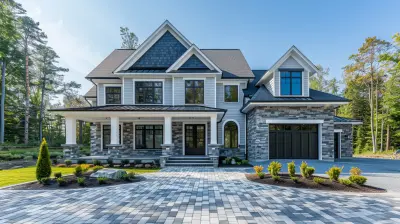How to Choose the Best Mortgage Term for Your Situation
24 November 2025
Buying a home is like jumping into a long-term relationship—you need to pick the right partner (aka, your mortgage) or you’ll be stuck in a financial nightmare. Seriously, no one wants a commitment that turns into monthly regret.
One of the biggest decisions you’ll make when getting a mortgage is choosing the right loan term. Should you go for a 15-year option and pay off your home faster, or stick with a 30-year term for lower monthly payments? Maybe you’re even considering something in-between.
Well, buckle up! We're diving deep into the world of mortgage terms—minus the boring finance lecture. 
What Exactly Is a Mortgage Term?
Let’s start with the basics. A mortgage term is the length of time you agree to repay your loan. It’s like setting an alarm—choose wisely, or you’ll either wake up late (and pay more interest) or too early (and stress your bank account).The most common mortgage terms are:
- 30 years – The “Netflix binge” of mortgages. You take it slow, enjoy lower payments, and spread it out.
- 15 years – The “gym membership” mortgage. Higher payments, but you’ll get strong (financially) faster.
- 20, 25 years, or custom terms – The “choose your own adventure” options.
Now, which one is right for you? Let’s break it down. 
30-Year Mortgage: Slow and Steady
A 30-year mortgage is the go-to for most homebuyers. Think of it like paying for a new car… for three decades.Why people love it:
✅ Lower monthly payments (more room for guilt-free takeout)
✅ Easier to qualify for a more expensive house
✅ Gives you financial flexibility for investments, vacations, or unexpected expenses
The catch?
🚨 You’ll pay way more in interest over time
🚨 You’ll stay in debt longer than some people stay married
🚨 Slower equity buildup, meaning it takes longer to truly “own” your home
Best for:
👉 First-time buyers, people who want financial breathing room, and those who prefer manageable payments over aggressive debt payoff.
15-Year Mortgage: The Speed Racer
If you choose a 15-year mortgage, you’re basically signing up to be financially buff. It's like switching from fast food to kale smoothies—tough at first, but worth it in the end.Why people love it:
✅ Pays off your loan faster (hello, mortgage-free life!)
✅ Lower interest rates—lenders love a short commitment
✅ Builds home equity much faster (you actually own your house sooner)
The catch?
🚨 Higher monthly payments (goodbye, weekend splurges)
🚨 Less flexibility for investments or emergencies
🚨 Harder to qualify for a bigger loan amount
Best for:
👉 High-income earners, budget-conscious buyers, and those who dream of being mortgage-free ASAP.
20- and 25-Year Mortgages: The Middle Ground
If you’re stuck between commitment issues and long-term financial goals, 20- or 25-year mortgages could be your perfect match.Why people love them:
✅ A lower interest rate than a 30-year loan
✅ Faster home equity buildup
✅ More manageable monthly payments than a 15-year mortgage
The catch?
🚨 Higher payments than a 30-year loan
🚨 Not as much interest savings as a 15-year option
Best for:
👉 People who want a compromise—faster payoff but with reasonable monthly payments.What About Adjustable-Rate Mortgages (ARMs)?
Oh, you like to live dangerously? Then you might be eyeing an adjustable-rate mortgage (ARM).Unlike a fixed-rate mortgage, where your rate stays the same, ARM rates start low but change over time. It’s like signing up for a streaming service at a discount… then watching the price creep up every year.
Why consider an ARM?
✔️ Lower initial rates mean cheaper payments at first
✔️ Great if you plan to move or refinance before rates rise
Why it’s risky?
⚠️ Rates fluctuate—your payments could spike unexpectedly
⚠️ Less stability for long-term homeownership
Best for:
👉 People who won’t live in the home long-term or who have strong financial backup plans.How to Pick the Right Term for YOUR Situation
Before you sign on the dotted line, ask yourself:🔹 What’s your budget? – Can you comfortably afford the payments?
🔹 How long do you plan to stay? – If you’re moving in five years, a 30-year loan may not be necessary.
🔹 Are you OK with debt? – Some folks sleep fine knowing they owe money, others don’t.
🔹 Do you have other financial goals? – Planning for retirement, college funds, or investing? Your mortgage should fit into the big picture.
Pro-Tip: Run the numbers!
Use a mortgage calculator to compare payments, interest rates, and the total cost over time.Final Thoughts 🚀
Choosing a mortgage term isn’t just about numbers—it’s about your lifestyle, financial goals, and what helps you sleep at night.- Want smaller payments and more flexibility? Go with a 30-year mortgage.
- Want to pay off your home fast and save on interest? A 15-year term is your best bet.
- Need a balance between the two? 20- or 25-year loans might be the sweet spot.
At the end of the day, your mortgage should work for YOU—not the other way around. Pick wisely, and your future self will thank you (probably with a stress-free vacation).
all images in this post were generated using AI tools
Category:
Mortgage TipsAuthor:

Camila King
Discussion
rate this article
1 comments
Judith McCarron
Choosing the right mortgage term isn’t merely a financial decision; it’s a crossroads of your future—where dreams either flourish or fade. Delve into the enigmatic layers of your financial landscape, for the term you select could unlock opportunities or shackle you in unforeseen ways. What will you choose?
November 24, 2025 at 1:09 PM


